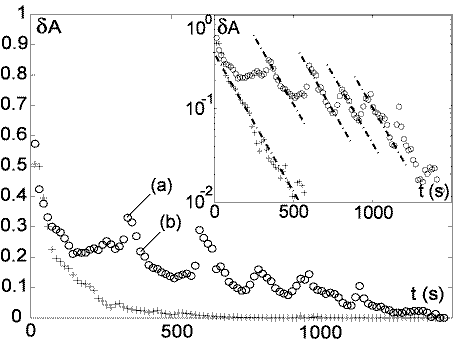

Mobile volume fraction evolution for two different realizations at similar pile slope : (o) q=15°; (+) q=16.5°. Inset is the log-lin plot of the same data.
A number of experimental works have studied surface instability of a granular heap, namely avalanches, and have led to the conclusion that such avalanches do not behave in a critical manner at all. In recent years, it has also been suggested that the jamming transition of granular materials could be analog to a glass transition. Further works on mean field glass models have developed this analogy and tried to unify concepts that had emerged in both fields, such as the dynamical temperature defined from fluctuation dissipation relations, and that related to Edwards' statistical ensemble.
First, the micro-displacements generated by a small localized overload at the free surface are visualized experimentally inside a packing of steel beads. For a triangular packing, beads rearrangements remain confined in two inverted triangles on both sides of the applied overload. This pattern disappears for stronger disorder. A simple model allows us to account for these observations and to relate them to the stress function response measured via photoelastic visualizations.
We have then reconsidered the avalanching pile problem but, instead of focusing on avalanches statistics, we have studied the relaxation of the pile towards mechanical equilibrium following an avalanche. We first have shown that the dynamics exhibits non-trivial relaxations and is much slower than expected given the "microscopic" time-scale. We observed intermittent bursts which reactivate the pile activity and identified them with correlated movements in space and time.
Perturbation experiments have allowed us to confirm the emergence of strong spatial correlations when increasing the pile slope, which are reminiscent of the clusters that we observed in flows. Finally we have extracted in the unperturbed case a two-time relaxation function, which can be shown to rescale in an aging like manner with a `reparametrization' of time suggested by a simple model that we introduce in order to describe our experimental data. Moreover, this model allows to relate the above relaxation function to a two-time correlation function which shares strong similarities with auto-correlation functions appearing in aging systems.
•  Systèmes complexes et transition énergétique › Physique statistique et systèmes complexes
Systèmes complexes et transition énergétique › Physique statistique et systèmes complexes
• UMR 3680 - Service de Physique de l'Etat Condensé (SPEC) • UMR 3680 - Laboratory of Condensed Matter Physics (SPEC)
• SPHYNX











